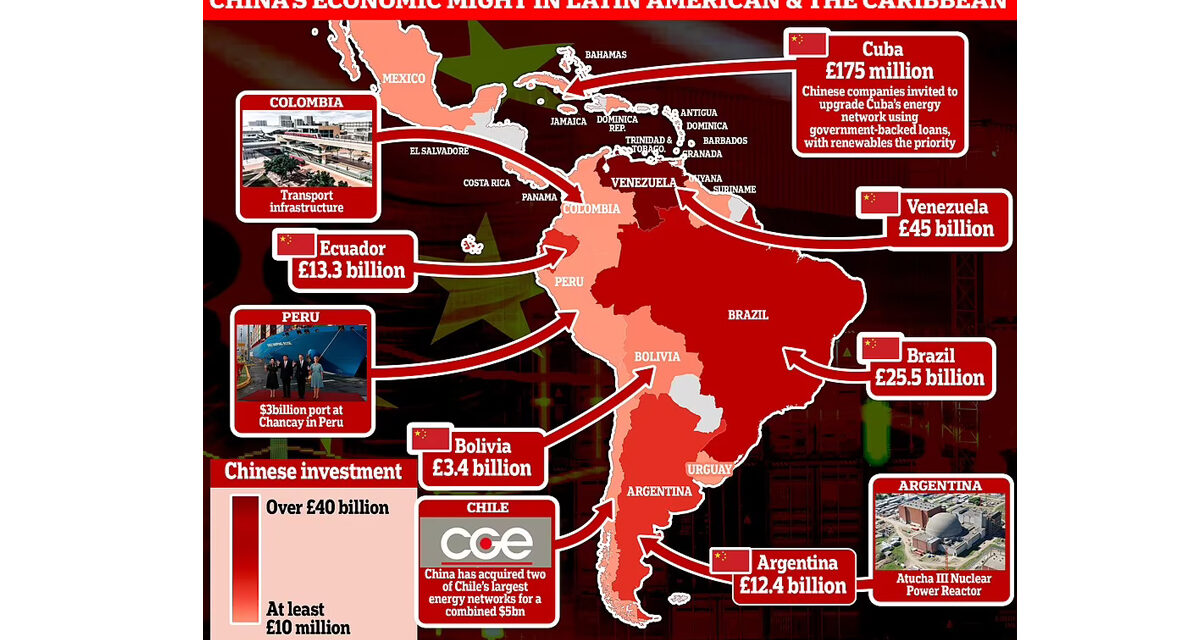
Is the U.S. Losing to China in Latin America?

The increasing sway of China in Latin America emerges as a profound transformation, challenging the longstanding dominance of the United States in the region. This development is not confined to the realms of economic engagement but spans a comprehensive strategy that integrates diplomatic efforts, public diplomacy, and information operations. China’s approach aims to cultivate and solidify its influence across Latin America and the Caribbean (LAC), weaving a narrative that contrasts markedly with traditional U.S. diplomacy.
Over the last two decades, China’s economic foothold in Latin America has surged, marked by its state-directed “policy banks,” like the China Development Bank and Export-Import Bank, providing over $138 billion in loans between 2005 and 2020. The leap in trade, from $12 billion in 2000 to an astonishing $445 billion by 2021, has not only spurred development in LAC countries but also underscored China’s role as an indispensable economic partner. This extensive economic relationship, however, is just one facet of China’s multifaceted engagement strategy. Beyond forging strong economic ties, China has adeptly paired its investments and trade with strategic diplomacy and compelling public messaging, focusing on mutual benefits and non-interference in the domestic affairs of countries—a stark contrast to the often prescriptive and governance-focused stance associated with U.S. foreign policy initiatives.

China’s commitment to expanding its influence in Latin America is further evidenced by the high level of diplomatic attention it has afforded the region. President Xi Jinping, for instance, has made eleven visits to Latin America since 2012, signaling the importance China places on its relationship with these countries. This is in sharp contrast to the comparatively limited engagement by U.S. presidents over the same period. Furthermore, China’s engagement extends beyond national governments, reaching out to local officials and investing in community-level projects, thus embedding its presence and influence at multiple levels within LAC countries.
China’s narrative in the region is meticulously crafted, delivered through media content-sharing agreements, social media engagement, and diplomatic outreach, highlighting themes of mutual benefit and respect for sovereignty. This narrative is consistent and monolithic, suggesting a highly centralized decision-making process. For instance, Chinese state media and diplomats have adeptly promoted narratives that paint China as a benevolent partner, dedicated to bringing economic opportunities without imposing political conditions. In Panama, the establishment of diplomatic relations with China was touted as a gateway to economic prosperity, with Chinese state-linked entities forging content-sharing agreements with major Spanish-language media to amplify this message.
In contrast, the U.S. response to China’s burgeoning influence in Latin America has been criticized for being belated, uncoordinated, and largely ineffective. Efforts to counter China’s presence, such as pressing LAC countries to exclude Chinese firms from their 5G networks, have met with limited success. The perception persists that the U.S. is more concerned with countering China than with addressing the needs and aspirations of Latin American countries.
The Biden administration, however, has sought to pivot from this approach, emphasizing economic resilience, democratic stability, and security, without framing its engagement as a direct response to China’s influence. Initiatives aimed at providing alternatives to China’s Belt and Road Initiative and revitalizing the Inter-American Development Bank represent steps toward reasserting U.S. commitment to the region. Yet, the success of these initiatives hinges on their implementation and the ability to effectively combine diplomatic engagement with tangible benefits that resonate with the needs of LAC countries.
As China’s economic growth slows and its financing in the region decreases, the U.S. faces an opportunity to recalibrate its strategy in Latin America. By focusing on positive messaging, outreach, and addressing the specific needs of LAC countries, the U.S. can offer an alternative to China’s engagement model. This requires not just increased investment and diplomatic attention but a genuine commitment to principles of mutual respect and cooperation.
The United States possesses unique advantages, including historical, cultural, and economic ties with Latin America, which could serve as the foundation for a reinvigorated partnership. Unfortunately, our current administration has no clue as to how to work with Latin America, nor even that there is an issue. We may lose to China without even realizing what we lost – until there are Chinese military bases in El Salvador, Peru or Nicaragua.
https://www.ft.com/content/789b2754-950b-4665-bf2d-afec61cea0ea

























The US is losing on many continents,,, thanks to Joe Biden!